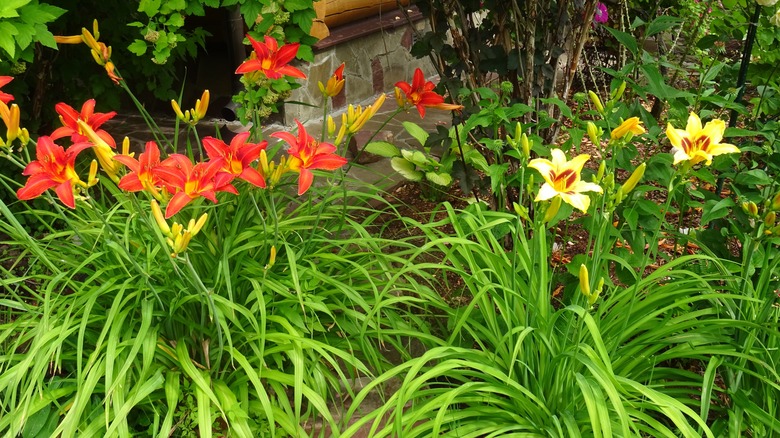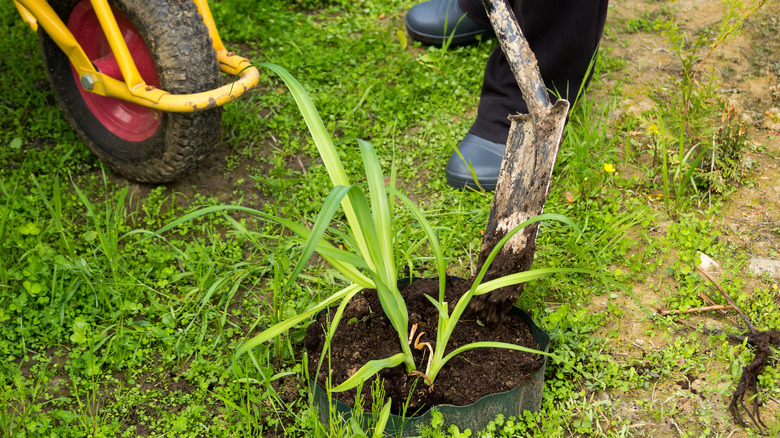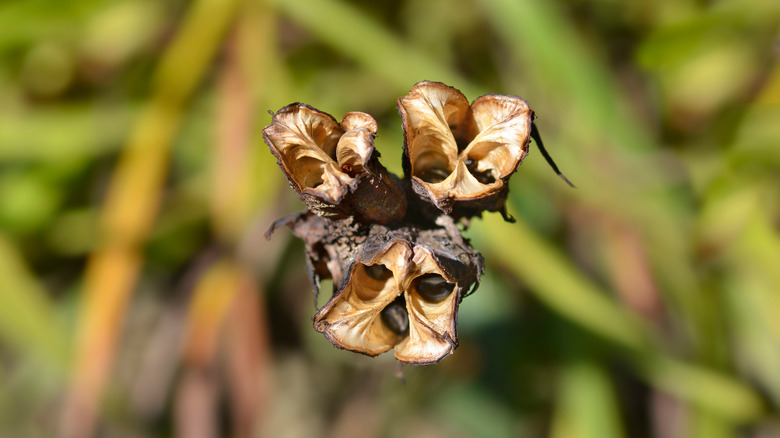Here's When You Should Plant Daylilies For A Garden Full Of Gorgeous Color
Is the ground soft enough to dig? If you said yes, you can plant daylilies. That's the short answer, and it holds true in warmer parts of the U.S. The longer answer is more ... nuanced. Cold-climate gardeners can get away with planting these hardy-blooming bulbs between early spring and late fall when the soil temperature is still average. Winter, well, you can't dig into the ground, can you? Plants grown from seed and those sourced from divided clumps have unique requirements, from stratification to overwintering to hardening off.
Whether you've purchased — or acquired or been gifted — bare-root stock (with or without bulbs) or plants in containers, the general planting advice from experts goes like this: plant daylilies as early in spring as the soil thaws up to a few weeks before the frost hits in the fall — if you get frosts, that is. In fact, a lot of nurseries, including daylily specialist growers, ship new plants starting in March and going through to October. Daylilies (Hemerocallis) are tough plants tolerant to drought, heat, and neglect. Disease-wise, they're really only affected by a few fungal pathogens — leaf streak, spot, and rust. If you're worried about a harsh winter damaging the tender new roots, aim for spring or late summer planting. It takes up to eight weeks for daylilies to establish a hardy root system.
Warm or cold?
Actually, it's a little more complicated than this broad advice makes it out to be. When you plant out your Hemerocallis varieties depends on where you garden. In the parts of the U.S.A. that experience chilly winters, say, USDA Hardiness Zones 1 to 8, planting in the spring is your best bet for success — late April to early May. Don't forget to mulch your beds in the fall to prepare your daylilies for colder weather, protecting them from crown-damaging snow and ice. In temperate climates, you can get away with putting new daylilies in the ground in summer, too.
If you're gardening in USDA Hardiness Zones 9 to 13, you have a lot more wiggle room with your daylily planting schedule. Almost all Hemerocallis cultivars prefer dry conditions with well-drained soils; their water-retaining roots may rot. If you live in the warmest parts of the Southern U.S., summers tend to be sticky — in the ground as much as in the air. The water-reserving roots of the daylily may start to rot. Avoid planting new daylilies or rootstock in the hottest months: July, August, and September; early spring or late autumn are better choices. It's also fine to put in new plants through the winter in most cases.
Planting seeds
Experts don't recommend growing daylilies from seed for a few reasons. Most Hemerocallis cultivars are hybrids, meaning the seeds you collect may not develop into lilies that look the same — bloom-wise — as their parent. Plus, seed-grown plants can take a lot longer to flower than bloom-ready nursery plants; you won't know what you have for a few seasons. If you still want to give it a go, cultivating daylilies from seed is generally pretty easy. They germinate readily, albeit slowly, given the right conditions. In cooler climates, this means sowing in the winter in a greenhouse or indoors under grow lights and hardening the resulting seedlings off in the early spring before planting them in the ground. If you have warm winters, you may need to stratify the seeds — expose them to a period of cold — before planting them in starter pots.
Arguably, the most cost-effective way of getting new daylily plants is by dividing a clump — the mass of rhizomes and tubers that spread down and out from the crown. When should you divide your daylilies? This essential garden task is best done after the plants have stopped flowering in late summer or the fall (August, some experts say, is ideal), but gardeners in warmer areas can get busy with their shovels any time of the year. Do this every three to five years, depending on how fast your daylilies are growing. Leave a few fans in the ground, and re-plant the rest of the rootstock immediately.


